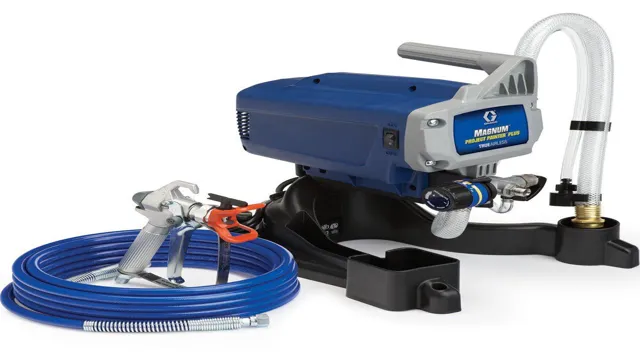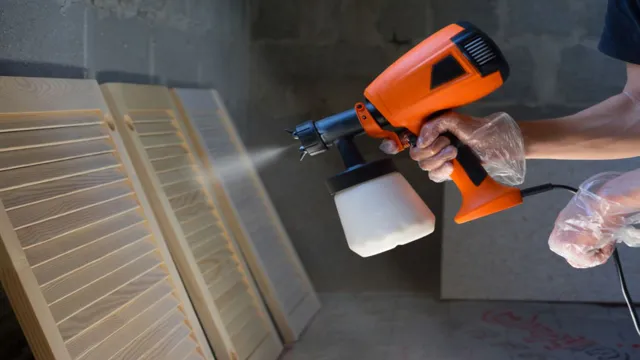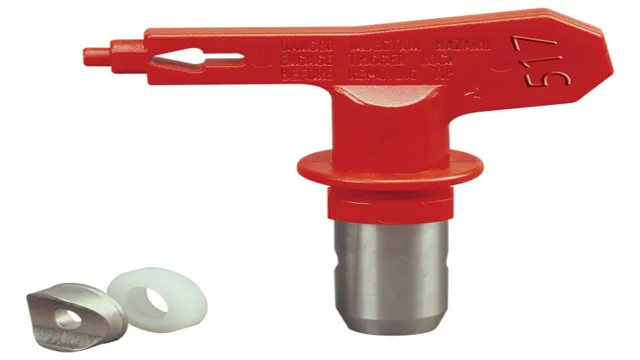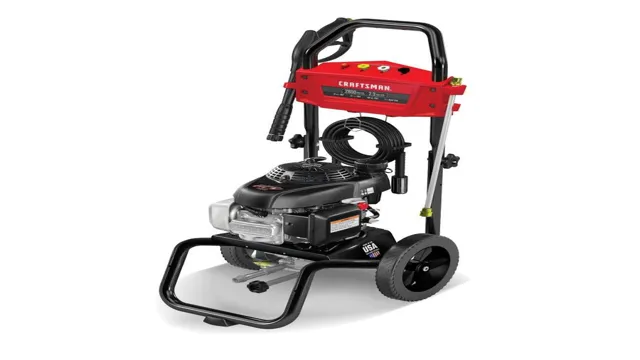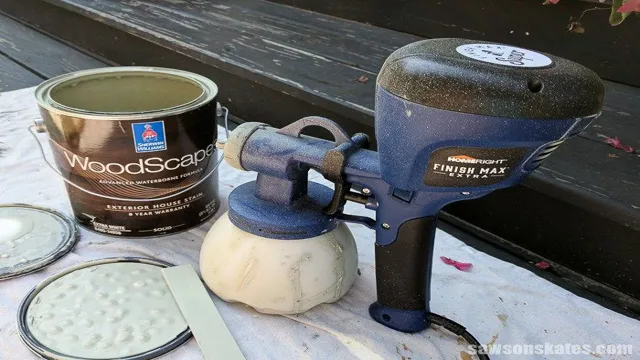Can You Use Wood Stain in a Paint Sprayer? Tips for Easy Spraying!

Do you want to give your old furniture a new lease on life? Have you considered staining it with wood stain? Wood stain can be a great way to update the look of your furniture without completely sanding it down or repainting it. But, have you considered using a paint sprayer to apply the stain? Using a paint sprayer can save you a lot of time and energy, and can even give you a more even finish. In this blog post, we’ll discuss the benefits of using wood stain in a paint sprayer, as well as provide some tips for achieving the best results.
So, grab your paint sprayer and let’s get started!
Understanding Wood Stain
If you’re wondering whether you can use wood stain in a paint sprayer, the answer is yes! Many DIY enthusiasts and professionals prefer using a paint sprayer to apply wood stain because it offers a consistent and even finish. However, it’s important to note that not all paint sprayers are compatible with wood stains. It’s recommended to use a paint sprayer that is specifically designed for staining or can handle the viscosity of the wood stain you plan to use.
Additionally, it’s crucial to properly dilute the wood stain and perform a test spray on a scrap piece of wood to determine the ideal settings. By using the right tools and techniques, you can achieve an impressive wood stain finish with a paint sprayer all on your own.
What is Wood Stain?
Wood stain is a type of finish that is applied to wood surfaces to bring out the natural beauty and color of the wood while also providing protection. It is made up of pigments and a binder that penetrates deep into the wood grain to give it a rich and vibrant color. Understanding how to use wood stain can be a bit tricky at first, as it requires some knowledge of the type of wood you are working with, the color of the stain you want to achieve and how to apply it properly for the best results.
However, once you have a good understanding of the process, it can be a very rewarding experience, as wood stain can transform an otherwise bland and boring wooden surface into a work of art. By selecting the right stain color, you can create a beautiful and unique finish that will bring out the natural beauty of the wood and add value and character to any interior space or piece of furniture.

Types of Wood Stain
Wood stain is a type of protective covering that’s used on wooden surfaces. Not only does it protect your wood from damage caused by weather, scratches, and natural aging, but it also enhances the overall appearance of the wood. Understanding the different types of wood stain is essential in deciding which one to use for your project.
One of the most common types of wood stains is water-based stains. These stains are non-toxic and easy to clean up, making them a popular choice for DIY projects. Oil-based stains are another popular option, offering a more durable finish and often creating a richer and deeper color.
Gel stains provide a thicker consistency, suitable for vertical surfaces as they are less drip-prone. Additionally, there are also specialty stains such as varnish and penetrating stains which offer unique properties such as being waterproof or resistant to fading. It’s essential to choose the right type of stain that suits your specific wood type and outcome needs.
Advantages and Disadvantages of Wood Stain
Wood stain is a popular way to give wood surfaces a new look. It provides a natural appearance while also protecting the wood from damage caused by water, UV light, and other environmental factors. There are several advantages to using wood stain, such as its ability to enhance the grain and color of the wood, as well as its durability.
Wood stain also helps to prevent warping, cracking, and splitting of the wood. However, there are also some disadvantages of using wood stain. One of the most significant downsides is that wood stain can be difficult to apply evenly.
It also requires a lot of preparation and maintenance to apply it correctly. Moreover, it may not be suitable for some types of wood. Overall, wood stain is an excellent way to enhance and protect your wood surfaces, but it is essential to weigh the advantages and disadvantages before deciding to use it.
Using a Paint Sprayer for Wood Stain
Wondering if you can use a paint sprayer for wood stain? The short answer is yes, you absolutely can! In fact, using a paint sprayer for wood stain can save you time and provide a more even finish. However, it’s important to make sure you are using the right kind of paint sprayer for the job. Airless sprayers, which use high pressure to atomize the paint or stain, are the most commonly used type for wood staining.
And when it comes to choosing the right stain for your sprayer, make sure to choose a thin, water-based stain that can easily be sprayed through the nozzle. With the right tools and materials, you can easily achieve a professional-looking finish with your trusty paint sprayer.
Can You Use a Paint Sprayer for Wood Stain?
Yes, you can use a paint sprayer for wood stain. Paint sprayers are versatile tools that can be used for various painting and staining projects. When using a paint sprayer for stain, there are a few things to consider.
First, make sure the sprayer is specifically designed for stains and finishes. Additionally, it is important to thin the stain to the color density appropriate for your project and to strain it before pouring it into the sprayer. Take the necessary precautions when using a sprayer by wearing proper safety gear, covering surrounding areas with protective drop cloths, and testing on a small area before tackling the larger project.
With the right prep and technique, a paint sprayer can provide a smooth and even application of wood stain, ultimately saving you time and effort. So, go ahead and give it a try for your next staining project and enjoy the beautiful finished result!
Benefits of Using a Paint Sprayer for Wood Stain
When it comes to staining wood, using a paint sprayer has numerous benefits compared to traditional methods. First and foremost, using a sprayer allows for a much more even and consistent application of the stain. This means less time spent going over missed spots or fixing uneven patches.
Additionally, since the sprayer applies the stain in a fine mist, it allows for a faster application and a much quicker drying time. This is especially beneficial if you’re working on a larger project or have limited time to dedicate to staining. Lastly, using a paint sprayer for wood stain allows for a much more efficient use of the stain itself.
When applied manually, it’s easy to use too much stain in certain areas, which can lead to uneven coloring and wasting of the product. Using a sprayer ensures that the stain is evenly distributed and only used where it’s needed. Overall, using a paint sprayer for wood stain is a smart choice that saves time, effort, and product.
Prepping Your Paint Sprayer for Wood Stain
Paint Sprayer, Wood Stain So, you’re ready to use your paint sprayer for applying wood stain – great choice! Before you dive right in, however, it’s essential to prep your paint sprayer properly. First, make sure your sprayer is clean. Any leftover paint can cause issues with your stain’s finish, so take the time to thoroughly rinse your sprayer with warm water.
Next, ensure your nozzle is the correct size for your wood stain. Using the wrong size can lead to uneven application or clogging. Additionally, make sure your sprayer is set up for stain application, as opposed to paint.
This may mean adjusting the pressure or using a different tip. Finally, don’t forget to test your sprayer on a piece of scrap wood to ensure everything is working correctly before starting your project. Now that you’ve prepped your sprayer, it’s time to get to staining!
Tips for Using a Paint Sprayer with Wood Stain
If you are wondering whether you can use wood stain in a paint sprayer, the answer is yes, you can! In fact, using a paint sprayer with wood stain can save you time and effort while achieving a consistent and even finish. However, before you start, here are some tips to help you get the best results. Firstly, make sure to choose a sprayer rated for use with thicker materials such as stains.
You should also test the spray pattern on a scrap piece of wood before proceeding to your actual project. It’s important to avoid overspray by adjusting the nozzle and controlling the pressure. And always wear protective gear, including gloves, goggles, and a respirator, to prevent injury or inhalation of harmful particles.
Finally, make sure to clean your equipment thoroughly after each use to prolong its lifespan and prevent clogging. By following these tips, you can confidently use a paint sprayer with wood stain and achieve a professional-looking finish.
Adjusting the Spray Pattern and Flow Rate
When using a paint sprayer for staining wood, it’s important to adjust the spray pattern and flow rate to achieve the desired finish. The spray pattern can be adjusted to be narrow or wide, depending on the size and shape of the wood surface. A narrow pattern is ideal for smaller areas, while a wider pattern is best for larger surfaces.
Similarly, the flow rate can be set based on the viscosity of the stain. A lower flow rate is best for thicker stains, while a higher flow rate is better for thinner stains. It’s important to test the spray pattern and flow rate on a small, inconspicuous area of the wood before starting the actual staining process to ensure the best results.
By using a paint sprayer with wood stain, you can achieve a smoother and more even finish in less time compared to traditional painting methods.
Choosing the Right Spray Tip
When it comes to using a paint sprayer with wood stain, choosing the right spray tip is crucial. It can make all the difference in achieving a smooth and even finish. The first thing you need to consider is the viscosity of your stain.
Thin stains will need a smaller tip size, while thicker stains will require a larger one. Secondly, the size of the project will determine the tip size you need. A small project may only require a tip size of 0.
011 inches, but a larger project may require a tip size of 0.015 inches or larger. It’s always best to consult the manufacturer’s recommendations for the specific product you’re using.
Lastly, don’t forget to check the spray pattern and adjust the pressure accordingly. With these tips in mind, you’ll be well on your way to achieving a professional-looking finish on your wood staining project.
Conclusion
In conclusion, using wood stain in a paint sprayer is like trying to fit a square peg into a round hole. Sure, it may seem like it could work, but ultimately it’s a recipe for disaster. Not only can it damage your sprayer equipment, but the stain may not adhere properly to the surface, resulting in an uneven finish.
So save yourself the trouble and stick to using paint in your paint sprayer, leaving the wood stain for traditional application methods. Your sprayer (and your wood project) will thank you!”
FAQs
What is wood stain?
Wood stain is a type of finish that enhances the natural color and grain of wood while providing protection against moisture and UV rays.
Can you use wood stain in a paint sprayer?
Yes, you can use wood stain in a paint sprayer, but you need to make sure that the sprayer is designed for spraying thin liquids and that you thin the stain appropriately for spraying.
What type of paint sprayer is best for applying wood stain?
HVLP (high volume, low pressure) paint sprayers are best suited for applying wood stain because they provide a fine, even mist that allows the stain to penetrate the wood evenly.
How do you thin wood stain for use in a paint sprayer?
You can thin wood stain by adding a small amount of mineral spirits or paint thinner until you achieve the desired consistency. Be sure to follow the manufacturer’s instructions and test the thinned stain on a scrap piece of wood before spraying.
Can you use a paint sprayer for applying polyurethane over wood stain?
Yes, a paint sprayer can be used to apply polyurethane over wood stain, but you need to make sure that the sprayer is properly cleaned and that you use a spray tip designed for applying clear finishes.
What precautions should you take when using a paint sprayer to apply wood stain?
Always wear appropriate personal protective equipment such as gloves, goggles, and a respirator. Cover any surrounding surfaces to protect them from overspray, and make sure that the sprayer is properly ventilated.
How do you clean a paint sprayer after using wood stain?
To clean a paint sprayer after using wood stain, flush the sprayer with an appropriate solvent such as mineral spirits or paint thinner. Disassemble the sprayer and clean all components thoroughly before storing.

